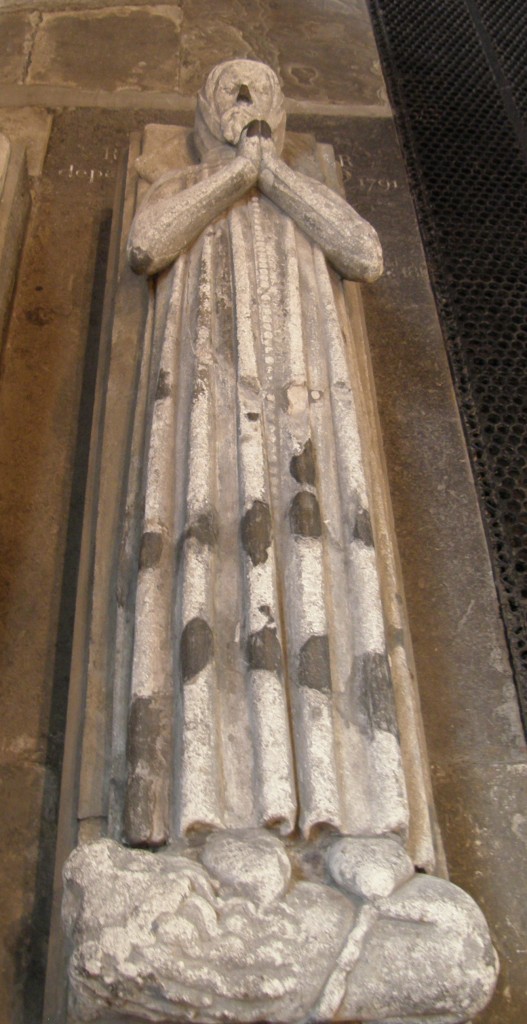Several years ago a woman named Edith Mary Pargeter began writing a series of murder mysteries set in the Middle Ages under the pseudonym of Ellis Peters. The “detective” protagonist of these mysteries was a monk named Cadfael. When dramatized by the BBC the actor Derek Jacobi played Brother Cadfael. Brother Cadfael’s monastic community was Shrewsbury Abbey, which is a real place. The abbey church of Shrewsbury Abbey still stands and is a functioning congregation of the Church of England. I visited the Abbey Church the morning of 12 July 2011.
Initially a small Saxon church, the Church of Saints Peter and Paul which was founded by Roger de Montgomery, a relative of William the Conqueror in 1083. It subsequently became a Benedictine Abbey and during the following 450 or so years it grew to become one of the most important and influential abbeys in England. In 1147, the relics of a Welsh Saint, Winefride, were brought to the Abbey and his shrine became an important place of pilgrimage. In 1283, the first English Parliament in which the Commons had a legal share took place in the Abbey Chapter House, and in 1398 Richard II summoned the Great Parliament in the Abbey. The Abbey was surrendered to the Crown in January of 1540 when Henry VIII disestablished the monasteries. Although much was destroyed, the nave continued to serve, as it does today, as the place of worship for the Parish of the Holy Cross.
In the nineteenth century plans for restoration of the Abbey were drawn up, but financial constraints compelled the building of only part of the plan; everything to the east of the pulpit and lectern are the work of the Gothic Revival architect John Loughborough Pearson, best known for designing Truro Cathedral; his work dates from 1886. The Pearson plans were put on hold and never completed because of the intervention of World War I.
Here are some pictures of the church:
This is the façade of the church seen from the small car park for the church staff:
This is the side of the church along which a major highway now runs (in the city of Shrewsbury this street is called Abbey Foregate, but it is national highway A5191 with lots of traffic). This would have been the side on which the cloister, dormitory, and other living spaces of the monastic community were built; you can see the ragged edges where the broken-down walls once adjoined the structure. The building is made of a red sand-stone native to the Shropshire area.
The interior of the church is quite large and spacious and, despite the dark stone from which it is built, natural light from the clerestory windows makes it quite bright. A very handsome painted reredos in the chancel (with a much gilt) fairly glows, and below it the altar is draped with a heavily embroidered frontal:
Around the side aisles of the church are tombs, such as these. The first picture is the tomb of a medieval priest; the second, of an Elizabethan couple.
There are numerous stained glass windows, old and new, such as these two. The first dates from the Middle Ages and shows the Adoration of the Magi; the second is of quite recent vintage and celebrates the Brother Cadfael series!
The ladies of Shrewsbury Abbey church were quite gracious when I visited. They have a small shop set up just inside the entrance to the church and a small coffee and tea bar at the rear of the left aisle. It was quite astonishing and rather funny to see a kitchen sink and countertop with modern appliances set up right next to an Elizabethan tomb, but this sort of “repurposing” is something the church needs to do and needs to do more frequently!
As I was about to leave, one of the ladies asked where I was from. I said, “Near Cleveland in the state of Ohio.” “Of course, you’re from America,” she said, “you such a lovely accent!” I nearly burst out laughing … I thanked her and went on my way, hoping to see a neolithic ring fort at Old Oswestry about an hour away. Unfortunately, road construction, indecipherable signage, and a GPS error made that impossible.












Eric:
Thank you for these blog entries and the pictures. I really feel like I’m on the trip with you, in some cases revisiting places I’ve been before, other times visiting new spots. It’s been a wonderful trip so far.
Eleanor
Eric, The photos of the windows are breathtaking. As is the church.
Thank you SO much for your blog and photos. Being wrapped up in the Cadfael stories, I felt I HAD to see the abbey. Gorgeous photos and descriptions! I felt sad to see the changes that time inevitably makes on historic sites, but that’s simply the way things are. All the best in your travels, from an arm-chair/book traveling neighbor from south-east Michigan!
Wendy – thanks for your note – I’m afraid my trip is completed, however. I was on sabbatical in England, Wales, Scotland, and Ireland last year (2011) from mid-June through mid-September. I kept the blog and posted the photos during that sabbatical and now use it as a place to post daily meditations. I hope you’ll find those as enjoyable as the photos and travelogue. Blessings, Eric
That is surely one of Christendom’s most beautiful altar frontals!